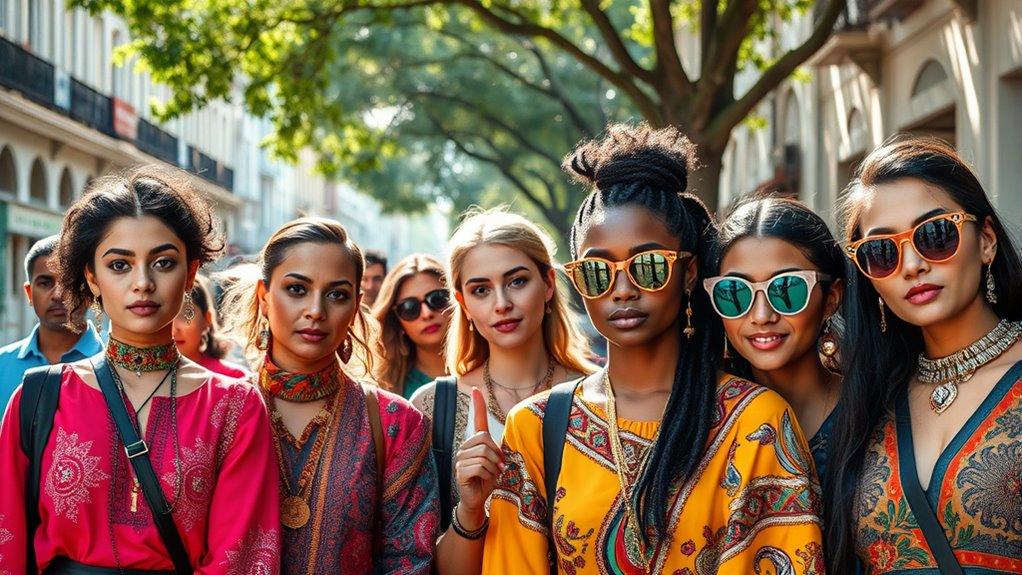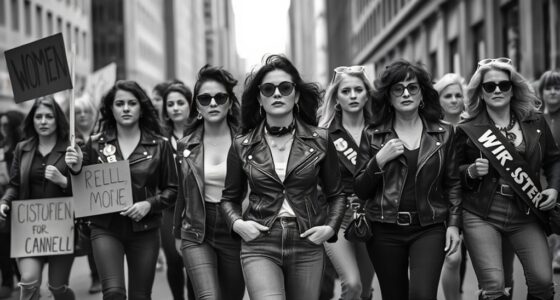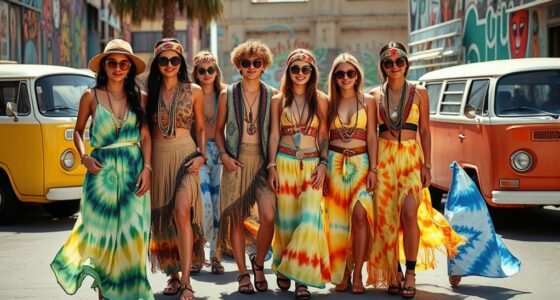Fashion reflects both your cultural roots and psychological drivers. Your style choices are influenced by societal values, traditions, and symbolism that communicate identity and beliefs. Personal motivations like seeking acceptance or expressing individuality shape trends you follow or create. External influences, social groups, and media amplify these effects, while future fashion will blend technology, sustainability, and inclusivity. If you keep exploring, you’ll discover how understanding these connections can help you craft authentic, meaningful styles.
Key Takeaways
- Culture influences fashion through symbolism, traditional craftsmanship, and societal values, shaping collective style preferences.
- Psychological drivers like self-expression, confidence, and social acceptance guide individual fashion choices.
- Fashion acts as a visual language reflecting personal identity and cultural stories, blending tradition with modern trends.
- Social influences, peer pressure, and celebrity endorsements accelerate trend adoption and conformity.
- Future fashion trends emphasize sustainability, technological innovation, and inclusivity, aligning cultural values with psychological needs.
The Cultural Roots of Fashion Trends
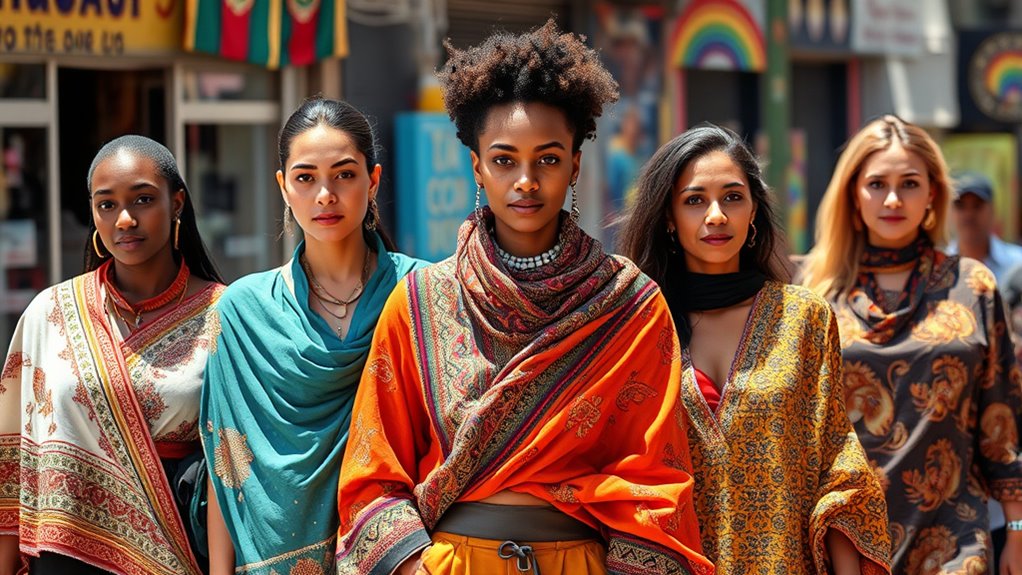
Understanding the cultural roots of fashion trends reveals how societies shape what you wear. Historical influences play a significant role, as past events and eras leave lasting marks on style choices. For example, the Renaissance inspired intricate fabrics and elaborate designs, reflecting societal values of wealth and artistry. Cultural symbolism also influences fashion, with colors, patterns, and accessories representing specific meanings. In many cultures, red symbolizes luck, while certain motifs indicate social status or spiritual beliefs. These symbols evolve over time, but their roots remain embedded in tradition. Additionally, the use of specific materials and craftsmanship techniques can be traced back to cultural practices and traditional skills, emphasizing the deep connection between fashion and cultural heritage. Recognizing the importance of Cultural symbolism helps us understand how fashion acts as a language of identity. By recognizing these influences, you see that fashion isn’t just about aesthetics; it’s a reflection of cultural identity and history. Your clothing choices are often woven with stories that connect you to your heritage and societal values. Moreover, contemporary fashion often incorporates elements from different cultures, creating a fusion of styles that highlights the global exchange of cultural ideas.
Psychological Drivers Behind Style Choices
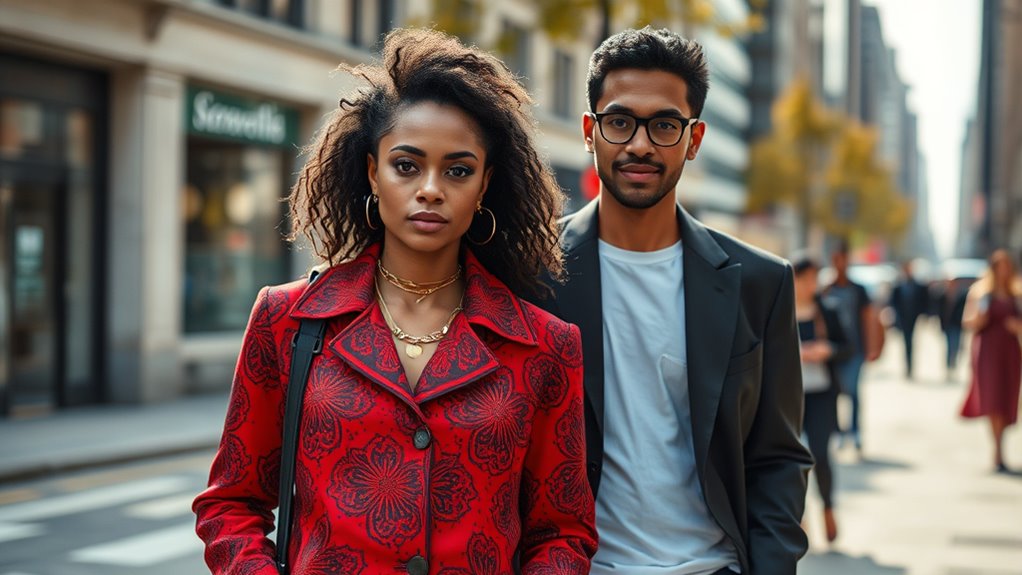
Your style choices are often driven by a desire to fit in and gain social acceptance. You also use fashion as a way to express your identity and stand out from others. Peer trends influence your decisions, shaping what you wear to stay connected and relevant. Additionally, understanding mindful decluttering can help you curate a wardrobe that aligns with your authentic self while reducing clutter and promoting sustainable choices. Recognizing the influence of fashion trends can further refine your personal style, ensuring it reflects both current influences and your individual preferences. Incorporating positive energy and a focused mindset can enhance your ability to attract styles that resonate with your true self.
Desire for Social Acceptance
The desire for social acceptance strongly influences the way people choose their style, often driving them to adopt trends that help them blend in or stand out within their social circles. This behavior stems from a need for belonging, guided by insights from fashion psychology and social conformity. You may find yourself copying styles admired by peers or sticking to popular items to avoid standing out negatively. The table below highlights common motivations behind these choices:
| Reason for Style Choices | Impact on Social Acceptance |
|---|---|
| Following Trends | Gaining peer approval |
| Conforming to Group Norms | Reducing social risk |
| Wearing Popular Brands | Enhancing social status |
Understanding these drivers helps clarify why style is so intertwined with our social lives.
Expression of Identity
People often use their style choices to communicate their unique identity and inner beliefs, making fashion a powerful form of self-expression. Color symbolism plays a key role in this, as different hues can convey emotions, values, or social messages—like red for passion or black for sophistication. Your clothing and accessories also serve as a language through body language, signaling confidence, openness, or individuality without words. When you choose certain styles, you’re actively shaping how others perceive you and reinforcing your personal narrative. Fashion becomes a mirror of your inner world, allowing you to project core aspects of your identity outwardly. By consciously selecting colors and styles, you communicate who you are and how you want to be seen, making fashion an essential tool for self-expression. Additionally, understanding the styles associated with different styles can further personalize your wardrobe and align your outward appearance with your inner identity. Recognizing signs of a checked-out partner can also influence how you express yourself through fashion, emphasizing confidence and individualism.
Influence of Peer Trends
Peer trends strongly influence individual style choices because humans are naturally social creatures who seek acceptance and belonging. Peer pressure plays a significant role, nudging you to conform to current fashion norms to fit in. When you see friends or peers adopting a certain style, you often feel compelled to follow suit, driven by the desire for trend conformity. This influence can lead you to prioritize popular aesthetics over personal preferences, reinforcing group identity. As a result, your style choices become less about self-expression and more about aligning with peer expectations. Understanding this psychological driver helps you recognize how much social dynamics shape your fashion decisions, making it clear that peer trends are powerful motivators behind many style shifts you experience. Additionally, the rise of AI security tools in monitoring behavioral patterns further underscores how external influences can impact individual choices within social contexts, highlighting the importance of awareness of social influence mechanisms. Recognizing the role of personality traits can also help you develop a more authentic style that aligns with your true self rather than solely conforming to external trends.
The Role of Identity and Self-Expression
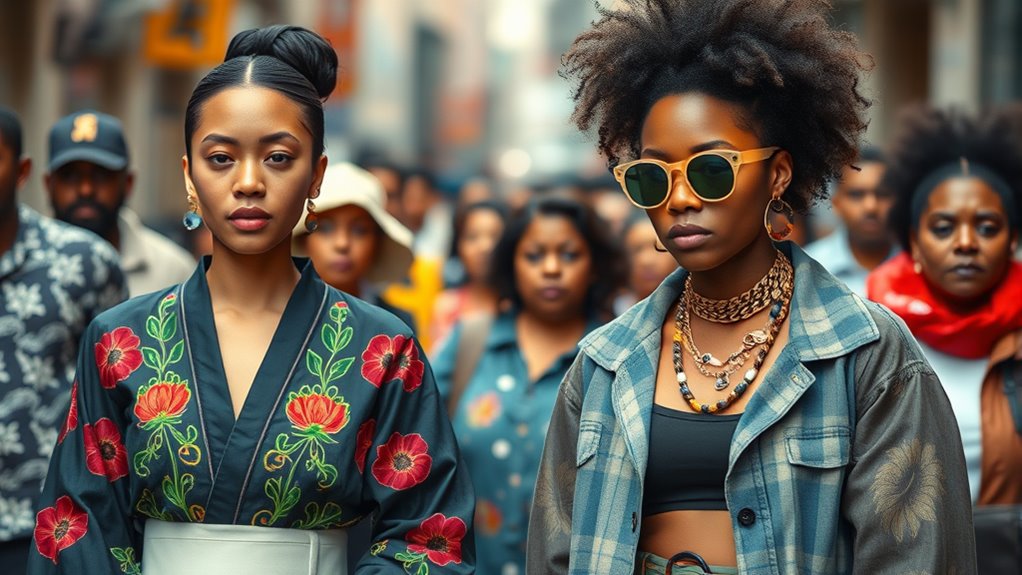
Your clothing choices often reflect who you are and what you want to express. Fashion becomes a tool for self-discovery, helping you explore different aspects of your identity. By selecting styles that resonate with you, you communicate your unique story to the world. Additionally, understanding fashion trends can provide insight into cultural influences and societal shifts that shape individual expression. Recognizing the importance of digital literacy and critical thinking skills can further help you interpret the cultural messages conveyed through fashion and media. Developing an awareness of media literacy allows you to critically analyze how fashion is marketed and the underlying messages it promotes.
Clothing as Personal Identity
Clothing serves as a powerful tool for expressing personal identity and conveying individual values. Through fashion psychology and clothing symbolism, you communicate who you are without words. Your choices reflect your personality, beliefs, and social standing. You might wear bold colors to showcase confidence or subtle tones to exude sophistication. The way you dress can signal group affiliations or challenge societal norms. Consider how a leather jacket or vintage band tee acts as a visual statement. Your wardrobe becomes a canvas for self-expression, shaping perceptions and interactions. By understanding clothing symbolism, you harness fashion’s ability to narrate your story. Additionally, staying informed about popular fashion trends can help you adapt your style to current cultural influences. Recognizing the influence of WWE Raw’s financial impact on global entertainment may inspire bold fashion choices that reflect confidence and success. Ultimately, your style choices are an extension of your identity, making clothing a essential form of personal expression.
Fashion and Self-Discovery
Fashion serves as a dynamic tool for self-discovery, allowing you to explore and understand your true identity. Through fashion psychology, you can express your evolving self and reflect personal growth. As self-expression evolves, clothing choices become a mirror of your inner world. This process helps you identify what resonates with you and builds confidence. Consider how different styles, colors, and accessories symbolize your journey. The table below illustrates key elements of self-expression:
| Style Type | Meaning | Example |
|---|---|---|
| Bold & Vibrant | Confidence and creativity | Bright colors, statement pieces |
| Minimalist | Simplicity and clarity | Neutral tones, clean lines |
| Vintage & Retro | Nostalgia and individuality | Unique accessories, classic cuts |
Your fashion choices reveal your evolving self and deepen your self-awareness. Understanding the Vetted Electric Bike Conversion Kits available can also inspire a sense of innovation and transformation, much like evolving personal style. Additionally, exploring different fashion trends can help you better understand how external influences shape your self-expression. Recognizing the influence of cultural factors can further enhance your understanding of style as a reflection of identity.
Social Influence and the Spread of Trends
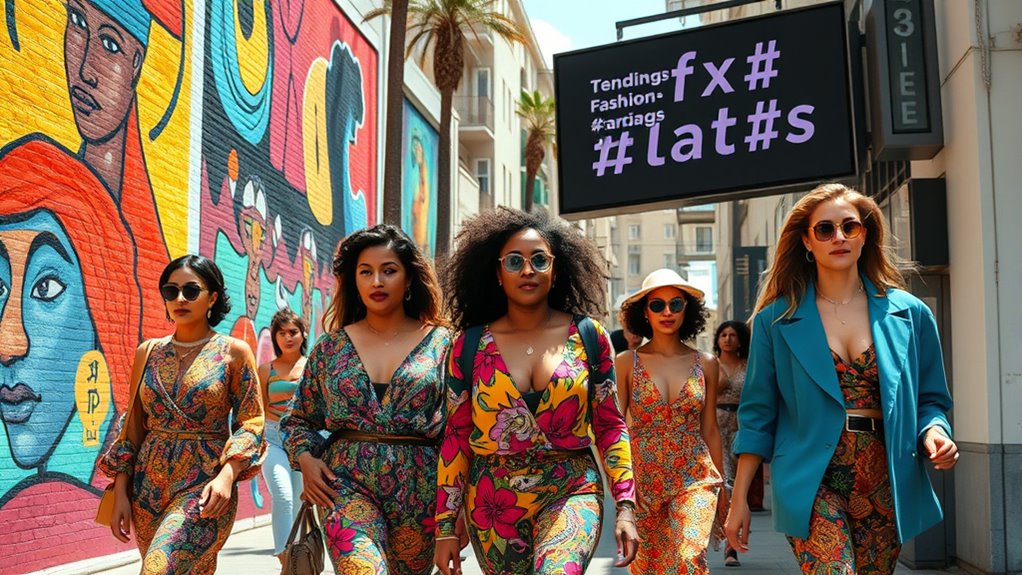
Social influence plays a crucial role in how fashion trends rapidly spread through society. You notice that viral marketing campaigns create buzz almost overnight, turning small ideas into widespread phenomena. Celebrity endorsements amplify this effect, as fans imitate their favorite stars’ styles. People feel compelled to follow trends promoted by influential figures, making these styles seem more desirable. Social media platforms act as accelerators, allowing trends to go viral in minutes. Peer groups also shape your choices, as you want to fit in with the latest look. The power of social influence hinges on trust and admiration, driving you to adopt new styles quickly. Additionally, digital literacy programs help individuals discern authentic trends from fads, ensuring more informed fashion choices. The interconnected web of influence is reinforced by social networks, which facilitate real-time sharing and discussion of trending styles, keeping the cycle of trend adoption dynamic and ongoing. Recognizing how social influence operates can help consumers make more intentional fashion decisions.
Fashion as a Reflection of Collective Values
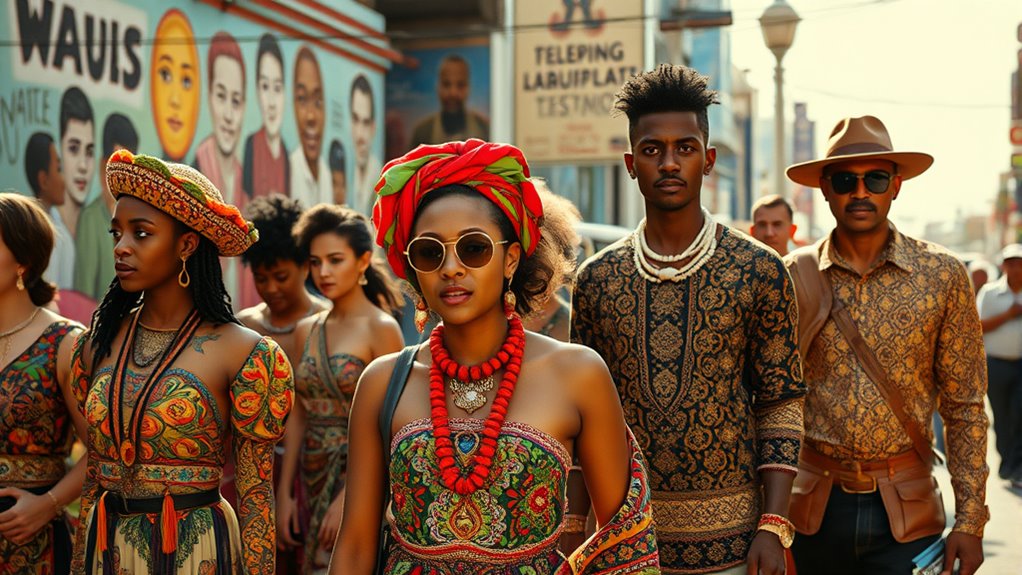
Fashion symbolism reveals what a culture prioritizes, whether it’s status, rebellion, or environmental consciousness. Cultural adaptation plays a key role here, as societies modify fashion trends to express their unique identities while embracing global influences. When you see traditional garments blended with modern elements, it shows how cultures adapt to changing values while honoring heritage. In this way, fashion becomes a visual language, communicating collective ideals without words. Your clothing choices can serve as a reflection of societal values, making fashion an active mirror of cultural identity. Additionally, understanding the 16PF personality traits of individuals can provide deeper insights into how personal values influence fashion preferences and expressions.
The Future of Fashion: Merging Culture and Psychology
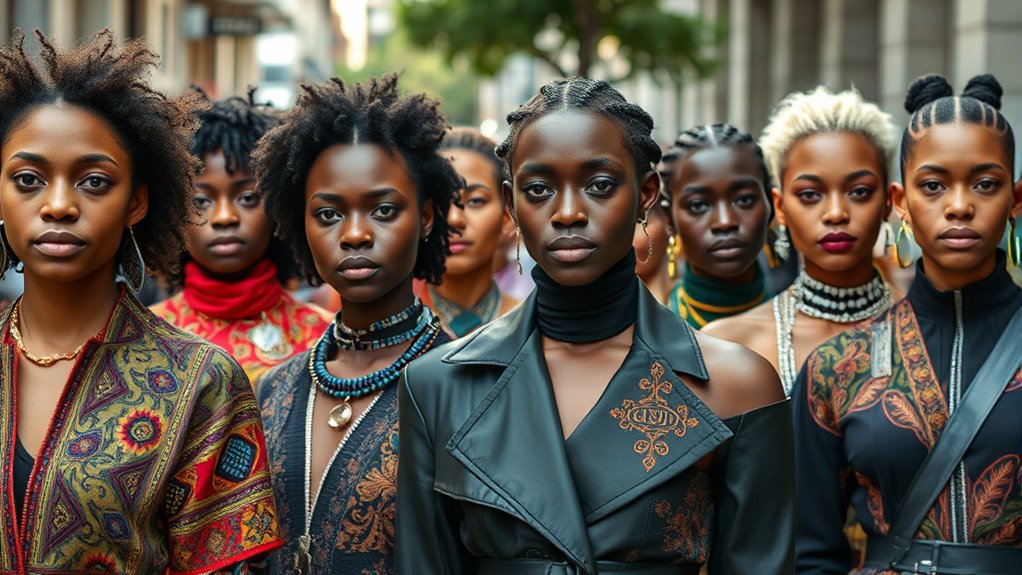
As cultural values continue to evolve and intersect with individual psychology, the future of fashion is set to become a dynamic blend of personal expression and collective identity. You’ll see brands prioritizing sustainable innovation, using eco-friendly materials and ethical practices to appeal to conscious consumers. Technological integration will revolutionize how you experience fashion, with virtual try-ons, AI-driven designs, and personalized shopping experiences becoming the norm. This merging of culture and psychology will foster deeper emotional connections with your wardrobe, reflecting your values and identity. Expect a shift toward more inclusive styles that celebrate diversity and mental well-being. The boundaries between physical and digital fashion will blur, creating innovative ways for you to express yourself while supporting sustainable growth and technological progress.
Frequently Asked Questions
How Do Fashion Trends Evolve Across Different Cultures Historically?
You observe that fashion trends evolve across cultures through cultural symbolism and historical fashion cycles. As societies change, they reinterpret symbols, blending traditional elements with modern influences. These cycles repeat, reflecting shifts in values and identities. By recognizing these patterns, you see how cultural symbolism drives trend development, while historical fashion cycles show how styles come back, adapt, and influence new generations across different cultures and eras.
What Psychological Traits Influence Individuals’ Fashion Preferences?
Imagine it’s 1920, and your personality traits shape your fashion choices just like today. Your self-esteem influences whether you opt for bold or subtle styles, revealing confidence or shyness. Traits like openness or extraversion drive you toward trendy or classic looks. You seek comfort or status, aligning your wardrobe with your self-image. Ultimately, your psychology guides your preferences, helping you express who you are without saying a word.
How Does Fashion Impact Perceived Social Status?
Fashion psychology shows that the way you dress acts as social signaling, impacting how others perceive your social status. When you choose trendy or luxurious clothing, you signal wealth, confidence, or belonging. Your style can elevate your perceived status, making you seem more influential or respected. By understanding these cues, you can consciously craft your look to project the social identity you want others to see.
Can Fashion Serve as a Form of Political or Social Protest?
Imagine you’re wearing symbolic clothing like a modern “Punk” outfit—it’s a form of fashion activism. Yes, fashion can serve as political or social protest, making statements without words. You use style to challenge norms, raise awareness, or support causes. Clothing becomes a visual language, turning fashion into a powerful tool for activism, allowing you to express your beliefs and stand in solidarity with movements through your choice of attire.
What Technological Innovations Will Shape Future Fashion Psychology?
You’re curious about how future fashion psychology will evolve. Technological innovations like augmented reality will let you virtually try on outfits, influencing your style choices and confidence. Wearable technology will provide real-time feedback on your mood and health, shaping your fashion decisions based on psychological insights. These advancements will make fashion more interactive and personalized, deepening your connection to clothing and how it reflects your identity.
Conclusion
Understanding how culture and psychology shape fashion helps you see trends as more than just fleeting styles. For instance, during the 1960s counterculture movement, bold clothing choices reflected a desire for freedom and rebellion. By recognizing these deeper forces, you can make more intentional style decisions that express your identity and connect with broader societal shifts. Ultimately, fashion becomes a powerful mirror of who you are and the world around you.
